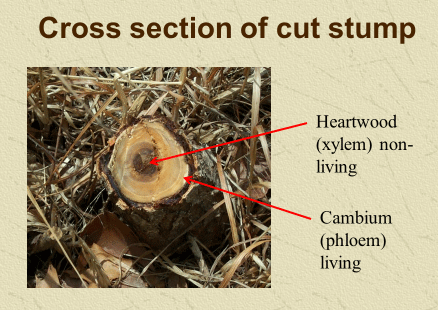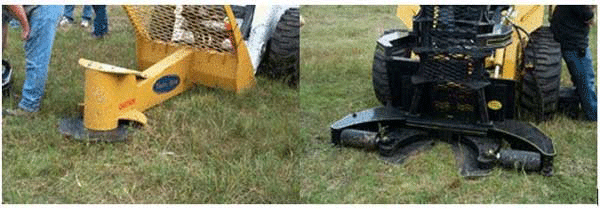Late summer and fall can be an excellent time to treat unwanted stands of woody plants. Scattered stands of individual trees should be treated individually using the basal bark method (for labeled plants less than 4-6 inches in diameter) or the cut stump treatment method. The basal bark and cut stump treatments will not be effective if the plants cannot be treated down to the soil line. Avoid conditions where water (or snow later in the season) prevents spraying to the ground line.
Basal bark application method
Producers can treat smaller diameter susceptible woody plants individually this fall by spraying the basal stem parts with triclopyr plus diesel fuel. The lower 12-15 inches of the stems or trunks of susceptible small trees should be thoroughly wetted on all sides with a triclopyr-diesel mixture. Triclopyr goes by the tradenames Remedy Ultra and Pathfinder II. Remedy Ultra is a 4 lb/gallon product. The labeled recommendations for Remedy Ultra are 20-30% solution in diesel. Pathfinder II is a ready-to-use product and does not have to be mixed with diesel. PastureGard HL is a premix of triclopyr and fluroxypyr and can be applied as a basal bark or cut-stump treatment as a 25% solution in diesel. Crossbow, a mixture of triclopyr and 2,4-D, can also provide control of certain woody plants as a 4% solution in diesel. Milestone, with the active ingredient aminopyralid, is effective on black and common honeylocust. Mix Milestone 5% v/v with a compatible basal oil, e.g., Dyne-Amic from Helena Chemical. Before selecting a basal oil, do a jar test by mixing Milestone and basal oil to determine compatibility.
Cut-stump method
If the woody plant is greater than 6 inches in diameter, the best method is to:
- Cut it off at ground level.
- Treat the cut surface with triclopyr and diesel fuel within 30-60 minutes before the sap seals over the exposed area.
- Spray the cambium and light-colored sapwood to ensure translocation of the herbicide (Figure 1).
- Treat any exposed trunk or exposed roots.
The stump of ash, cottonwood, elm, oaks, persimmon, willow, and Russian olive can be treated with a 1:1 ratio of dicamba (Clarity, Sterling Blue) in water instead of triclopyr if desired. The stumps of Eastern red cedar do not need to be treated since, unlike many woody plants, this species does not root sprout. Simply cutting Eastern red cedar below the lowest green branch will kill it. Common trees in Kansas that re-sprout after cutting include: ash, cottonwood, elm, oaks, osage orange (hedge), persimmon, black and common honey locust, saltcedar, and Russian olive. In sprouting species, new shoots arise from dormant buds at or below the ground often resulting in a multi-stemmed clump.

Figure 1. Treat the cambium tissue for cut-stump treatments.
Table 1. Cut-Stump Herbicides
|
Herbicide |
Active ingredients per gallon |
Rate |
|
Crossbow1 |
2 lb 2,4-D + 1 lb triclopyr |
4% in diesel |
|
Remedy Ultra |
4 lb triclopyr |
20-30% in diesel |
|
Pathfinder II |
0.75 lb triclopyr |
Ready to use |
|
PastureGard HL |
3 lb triclopyr + 1 lb fluroxypyr |
25% in diesel |
|
Milestone |
2 lb aminopyralid |
10% in water |
|
Sterling Blue/Clarity |
4 lb dicamba |
25-50% in water |
|
Roundup PowerMAX |
5.5 lb glyphosate |
50-100% in water |
|
Arsenal |
2 lb imazapyr |
10% in water |
|
Tordon 22K |
2 lb picloram |
10% in water |
|
Capstone |
0.1 lb aminopyralid + 1 lb triclopyr amine |
Undiluted |
1 Trade names are used to help identify herbicides. No endorsement is intended, nor is any criticism implied of similar products not mentioned.
Common honeylocust can re-sprout from a wide diameter area around the main plant because of root suckers. One option is to make a basal bark treatment with triclopyr-containing products to kill the entire plant in the fall. Then the main plant can be cut down in subsequent years once the tree dies. Cut-stump applications of Milestone as a 10% solution in water have been more effective than triclopyr on common honeylocust.
Table 2. Cut-Stump Treatments
|
Species |
Herbicides |
|
Ash |
Crossbow, Pathfinder II, PastureGard HL, Banvel/Clarity, Arsenal, Capstone |
|
Common honeylocust |
Remedy Ultra, Pathfinder II, PastureGard HL, Milestone, Sterling Blue/Clarity, Tordon 22K, Capstone |
|
Cottonwood |
Crossbow, Remedy Ultra, Pathfinder II, Sterling Blue/Clarity, Arsenal, Tordon 22K, Capstone |
|
Elm |
Crossbow, Remedy Ultra, Pathfinder II, PastureGard HL, Banvel/Clarity, Arsenal, Tordon 22K, Capstone |
|
Oaks |
Remedy Ultra, Pathfinder II, PastureGard HL, Banvel/Clarity, Roundup PowerMAX, Arsenal, Tordon 22K, Capstone |
|
Osage orange (hedge) |
Remedy Ultra, Pathfinder II, PastureGard HL |
|
Persimmon |
Remedy Ultra, Pathfinder II, PastureGard HL, Sterling Blue/Clarity, Arsenal, Capstone |
|
Russian olive |
Crossbow, Pathfinder II, Sterling Blue/Clarity, Arsenal |
|
Salt cedar |
Remedy Ultra, Pathfinder II, PastureGard HL, Roundup PowerMAX, Arsenal |
|
Willow |
Crossbow, Remedy Ultra, Pathfinder II, PastureGard HL, Roundup PowerMAX |
Tordon RTU and Pathway can be used on cut surfaces in noncropland areas such as fence rows, roadsides, and rights-of-way. However, Tordon RTU and Pathway are not labeled for use on range and pasture. Glyphosate labels vary on what sites are labeled for cut-stump application on rangeland. Roundup PowerMAX can be applied on any terrestrial site. Roundup ULTRA can only be applied as a cut-stump treatment on non-cropland. Be sure to check the label, as rangeland is sometimes included as a site under non-cropland on some glyphosate labels.
Application equipment for cut-stump application includes pressurized hand sprayers, small backpack sprayers, sprayers mounted on ATVs with a handheld gun, hydraulic tree shears or saws with an attached spray nozzle, or even a paintbrush. Two of the more common pieces of equipment for cutting the woody plants are the turbo saw and the hydra clip (Figure 2).

Figure 2. Turbo saw (left) and hydra clip (right).
Although animal exposure is reduced by basal and cut-stump treatments, grazing and haying restrictions still need to be followed. There are no restrictions before grazing with any of the herbicides discussed. Check labels for restrictions for use before hay harvesting, removal of animals before slaughter, and for use around lactating dairy animals.
Application tips for using cut-stump treatments:
- Always follow the directions on the herbicide label.
- Before spraying, brush any sawdust or debris off the cut surface.
- Apply herbicide to freshly cut stump.
- Spray cut surface and stump to ground level.
- Spray exposed roots above the soil surface.
- The cambium layer is the critical area to spray.
- Apply enough liquid that it pools on the cut surface.
Walt Fick, Rangeland Management Specialist
whfick@ksu.edu